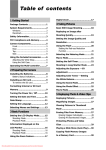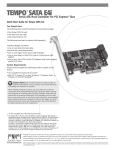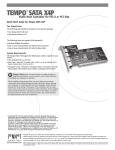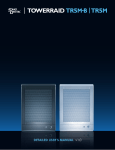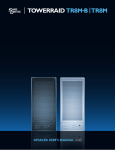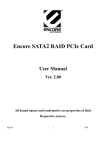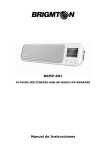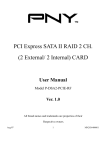Download 2-CHANNEL SATA II PCI EXPRESS CARD User Manual
Transcript
2-CHANNEL SATA II PCI EXPRESS CARD User Manual 1 Features and Benefits Silicon Image SiI 3132 Compliant with PCI Express Base Specification 1.0a Compliant with Serial ATA 1.0 specification with support for full complement of SATA II optional features Installs in any available PCI Express slot and supports data transfer rates up to 3.0Gbps Supports Native Command Queuing (NCQ), Non-zero offsets NCQ, and Out-of-order data delivery NCQ Supports RAID 0(striping) and RAID 1(mirroring) for speed and data protection respectively System Requirements PCI Express-enabled system with one available PCI Express slot Windows 7, Vista, XP, 2000 Package Contents 1x SiI 3132 SATA II PCIe RAID adapter 1x Driver CD 2x SATA Data Cables & 2 x SATA Power Cables 1x Manual 2 Hardware Description E (Jumper Settings) JP J1-J4 J5-J8 Description Active Port 1-2 close Enable SATA Port A 2-3 close Enable SATA Port C 1-2 close Enable SATA Port B 2-3 close Enable SATA Port D 3 Hardware Installation 1. Turn Off the power to your computer and any other connected peripheral devices. 2. Unplug the power cord from the back of the computer. 3. Remove your computer’s cover. 4. Remove the slot bracket from an available PCI Express slot. 5. To install the card, carefully align the card’s bus connector with the selected PCI Express slot on the motherboard. Push the board down firmly, but gently, until it is well seated. 6. Replace the slot bracket’s holding screw to secure the card. Device Connection Serial ATA hard drives should come with their own accessories. In most cases, you just need to power up the device and connect them to the ports. The SiI 3132 SATA II PCIe RAID adapter is two channel Serial ATA controller that supports two Serial ATA hard disk drives. It is recommended to use identical drives for all RAID configurations. However, it’s possible to combine hard drives of different sizes and makes. 4 RAID Arrays RAID Arrays are setup in the SiI 3132 SATA PCIe RAID adapter’s BIOS. RAID 0 (Striping) This RAID array to be used on New/Blank hard drives. Striping will destroy existing data on the hard drive. Auto Configuration is recommended. For applications that require custom chunk size, Manual Configuration is offered. Auto configuration (recommended) The default chunk size is 64k when selecting Auto configuration. 1. As the BIOS boots press Ctrl+S or F4 when prompted to enter the RAID BIOS. 2. At the next screen select Create RAID Set, then press Enter. 3. Select RAID0, then press Enter. 4. Select Auto configuration, then press Enter. 5. Input the RAID size, press Enter. 6. When asked Are You Sure (Y/N)?, press Y to accept. 7. Press Ctrl+E to exit the BIOS. 5 8. When asked Are you sure to exit (Y/N)?, press Y to exit and reboot. 9. Continue with FDISK and FORMAT steps as if you were installing a conventional hard drive. Manual configuration 1. As the BIOS boots press Ctrl+S or F4 when prompted to enter the RAID BIOS. 2. At the next screen select Create RAID Set, then press Enter. 3. Select RAID0, then press Enter. 4. Select Manual configuration then press Enter. 5. Select chunk size from 8k, 16k, 32k, 64k or 128k, then press Enter. 6. Select the first drive, press Enter. 7. Select the second drive, press Enter. 8. Input the RAID size, press Enter. 9. When asked Are You Sure(Y/N)?, press Y to accept. 10. Press Ctrl+E to exit the BIOS. 11. When asked Are you sure to exit(Y/N)?, press Y to exit and reboot. 12. Continue with FDISK and FORMAT steps as if you were installing a conventional hard drive. 6 RAID 1 (Mirror) For New/Blank Hard Drives 1. As the BIOS boots press Ctrl+S or F4 when prompted to enter the RAID BIOS. 2. At the next screen select Create RAID Set, then press Enter. 3. At the next screen select RAID1 then press Enter. 4. Select Auto configuration, then press Enter. 5. Input the RAID size, press Enter. 6. When asked Are You Sure(Y/N)?, press Y to accept. 7. Press Ctrl+E to exit the BIOS. 8. When asked Are you sure to exit(Y/N)?, press Y to exit and reboot. 9. Continue with FDISK and FORMAT steps as if you were installing a conventional hard drive. For Existing Hard Drives with Data 1. As the BIOS boots press Ctrl+S or F4 when prompted to enter the RAID BIOS. 2. At the next screen select Create RAID Set, then press Enter. 3. At the next screen select RAID1 then press Enter. 4. Select Manual configuration, then press Enter. 5. Select the Source drive, press Enter. 7 6. Select the Target drive, press Enter. 7. Select Create with data copy, then press Enter. 8. Select online copy, then press Enter. Note: Selcting Online Copy builds the mirror while in Windows. Selecting Offline Copy builds the mirror before exiting the RAID BIOS. 9. Input the RAID size, press Enter. 10. Press Ctrl+E to exit the BIOS. 11. When asked Are you sure to exit(Y/N)?, press Y to exit and reboot. CONCATENATION (JBOD) This RAID array allows you to use one or two hard drives to a JBOD(Just a Bunch Of Disks) array. Although JBOD doesn’t offer other RAID functionality, it makes the hard disks appear to be a single one by combining the drives into one larger logical one without any capacity loss. Rebuilding a Failed Mirror Set When a failure to one member occurs, you will be notified by the RAID BIOS during boot. The steps below will guide you in rebuilding a failed mirror set. 8 1. Replace he failed drive(s) with one of equal or greater capacity, then start the computer. 2. During boot press Ctrl+S or F4 to enter the RAID BIOS. 3. Select Create RAID Set press Enter. 4. Select SPARE DRIVE, then press Enter. 5. Select the single hard drive then press Enter. 6. Input RAID size, press Enter. When asked Are You Sure(Y/N)?, Press Y to confirm. 7. Select Rebuild Raid 1 Set, press Enter. 8. When asked Are you sure(Y/N)?, press Y confirm. The mirror will begin rebuilding. Do not interface with processs. 9. When rebuilding is finished, press Ctrl+E. 10. When asked Are you sure to exit(Y/N)?, press Y to exit and reboot. Deleting RAID Arrays 1. As the BIOS boots press Ctrl+S or F4 when prompted to enter the RAID BIOS. 2. Select Delete RAID Set, then press Enter. 3. Select the RAID set then press Enter. 4. When asked Are You Sure(Y/N)?, press Y to confirm. 9 Resolving Conflicts When a RAID set is created, then metadata written to the disk includes drive connection information. If, after a disk failure, the replacement disk was previously part of a RAID set (or used in another system), it may have conflicting metadata. If so, this will prohibit the RAID set from being either created or rebuilt, in order for the RAID set to function properly, this old metadata must be first overwritten with the new metadata. To resolve this, from the main BIOS window select Resolve Conflicts, then press Enter, the correct metadata, including the correct drive connection information, will be written to the replacement disk. Low Level Format Low Level Format is build into the RAID BIOS to make it more convenient to erase the entire contents of a hard disk drive, including data, drive and partition information. The Low Level Format utility works on single hard drive only, before the RAID set is configured. Logical Drive Info This menu item allows the display of the assignment of physical drives within a logical set(RAID0, RAID1, etc.). This is display 10 only function. BIOS Configuration The SiI 3132 SATA II PCIe RAID adapter BIOS will appear every time your system starts up. If the BIOS doesn’t show, please try your controller in another PCI Express slot. During this (POST) process, the BIOS will show up and indicate the devices attached to it. Driver Installation For Windows® XP/Server 2003 For New Installation A new installation requires a floppy disk for the driver installation. To make this floppy disk, copy the contents of the “DS-30102\2K_XP_2003_Vista” folder, found on the driver CD, onto a blank floppy disk then follow the directions below. 1. Setup the RAID Array prior to Windows installation. 2. Follow Microsoft’s Windows installation procedure. 3. Restart the computer when prompted by Windows’ installation. 4. At the Windows Setup screen, press F6 to install the RAID driver. 11 5. When prompted, press S to specify the location of the driver. 6. Insert the floppy disk, then press Enter. 7. Select Silicon Image SiI 3132 SoftRaid 5 Controller for Windows XP/Server 2003, then press Enter. 8. Press Enter to finish driver installation, then follow the on-screen instructions to complete the Windows installation. Note: If the Security Alert warning pops up, click Yes. Our driver has passed Microsoft compatibility testing, this message appears during new installation. For An Existing Installation 1. Setup the RAID Array prior to driver installation and boot up to Windows. 2. At the Found New Hardware Wizard: XP(w/SP1 or earlier)/Server 2003: continue to step #3 XP(w/SP2 or later)/Server 2003(w/SP1 or later): select No, not this time, then click Next. 3. Insert the driver CD, select Install the software automatically (Recommended), and click Next. 4. Accept the default entry, then click Next. 5. Click Finish. 6. Repeat steps 2-5. 12 7. Click Yes to restart to complete the installation. For Windows® 2000 For A New Installation A new installation requires a floppy disk for the driver installation. To make this floppy disk, copy the contents of the “DS-30102\2K_XP_2003_Vista” folder, found on the driver CD, onto a blank floppy disk then follow the directions below. 1. Setup the RAID Array prior to Windows installation. 2. Follow Windows® 2000 installation procedure. 3. Restart the computer when prompted by the installation. 4. At the Windows® 2000 Setup screen, press F6 to install the RAID driver. 5. When prompted, press S to specify the location of the driver. 6. Insert the floppy disk, then press Enter. 7. Select Silicon Image SiI 3132 SoftRaid 5 Controller for Windows 2000, then press Enter. 8. Press Enter again to finish driver installation, then follow the on-screen instructions to complete the Windows installation. 13 For An Existing Installation 1. Setup the RAID Array prior to driver installation and boot up to Windows. 2. At Found New Hardware Wizard, click Next. 3. Select Search for a suitable driver for my device(recommended) then click Next. 4. Insert the driver CD, check CD-ROM drives, uncheck the other boxes, click Next, then click Next again. 5. If the Digital Signature Not Found message appears, click Yes. Our driver has been thoroughly tested for stability and compatibility. 6. Click Next, then Finish. 7. Repeat steps 2-6. 8. Click Yes to restart to complete the installation. To Verify Windows® 2000/XP/Server 2003 Installation 1. Right click My Computer and click Manage. 2. Select Device Manager. 3. Double click SCSI and RAID Controller, then double click Silicon Image SiI 3132 SoftRaid 5 Controller to display 14 driver properties. A message this device is working properly is displayed in the dialog box, the driver has been correctly installed. 15



















